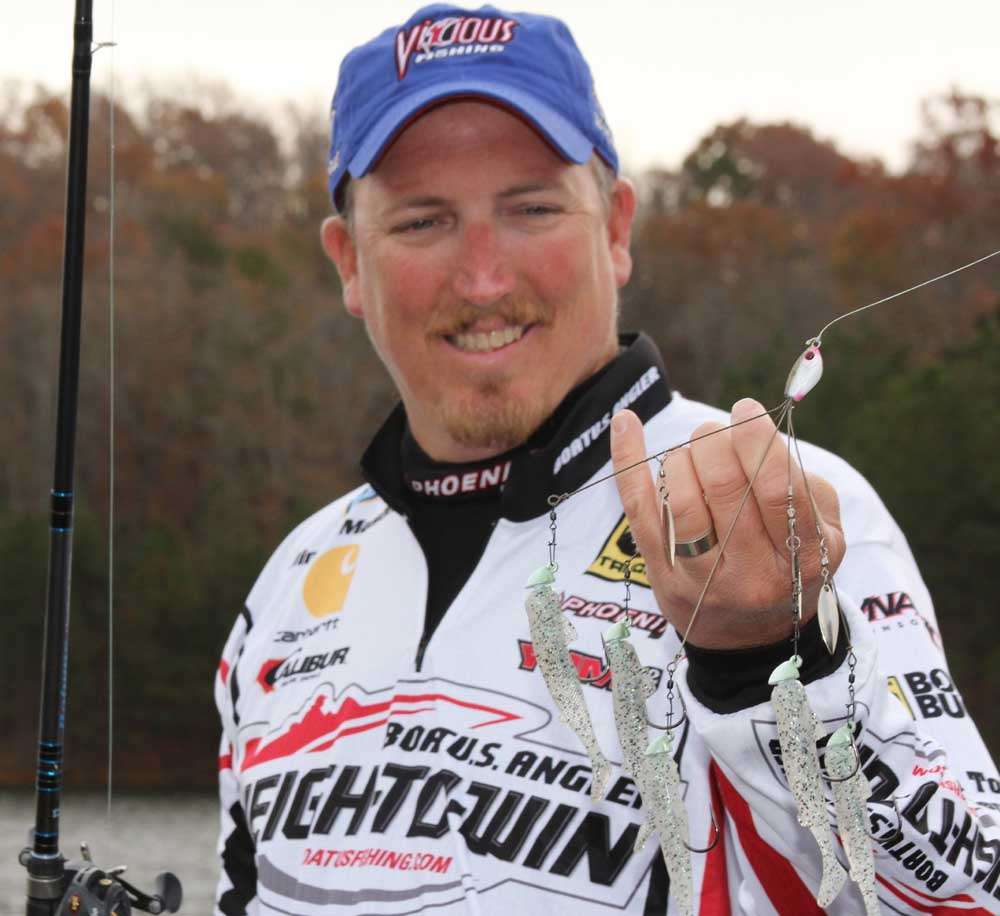
There aren’t many anglers who have enjoyed as much success with the castable umbrella rig (Alabama rig) as Bassmaster Opens pro Jimmy Mason.
The Rogersville, Ala., pro says it’s become a valuable tool in his guide service on the Tennessee River system and a top choice for fishing in late fall and most of the winter.
The rig consists of multiple wire arms sprouting from a head to which the fishing line attaches. Lures are fixed to each wire arm, which creates the image of a school of baitfish moving through the water.
“It’s something you can put in the hands of an inexperienced angler, and if they can cast, they can catch bass on it,” he insisted.
You can increase your success, said Mason, by employing a few tricks he’s learned the past couple years. Here’s how:
Gear up properly
Many anglers step into his guide boat ill-equipped. Mason says you need a rod with a handle measuring a minimum of 10 inches, an overall length of about 8 feet and an action that allows the rod to bend in the center.
“These baits are a load to throw and can really wear you out,” he explained. “The longer handle allows you to grip with both hands while casting, and the length and bend enables the rod to load and launch a long cast with less effort.”
Some rod companies offer swimbait models, but he likes the Dobyns 804 Big Carolina Rig rod.
You also need a large capacity baitcast reel that can handle at least 160 yards of 65-pound Vicious braid, which he prefers for his castable umbrella rigs (CURs). He uses a Lew’s Super Duty baitcaster designed for heavy baits and prefers a 6.4:1 geared reel.
“That gear ratio allows you to speed up or slow down as needed,” Mason noted.
Vary the retrieve
The standard slow-roll retrieve will catch fish, but Mason likes to “stutter-step” his retrieve, meaning he will wind the bait then do a half-turn hesitation.
“That allows the bait to flutter, and when you pick up on the retrieve, the bass often grab it,” he said.
During the summer months, when fish are on the bottom or suspended, he lets the rig flutter to the appropriate depth then cranks it fast a few turns. That presentation often catches them best.
“Pay attention to the location of the fish on your graph and experiment with retrieve until you figure out how the fish want it,” Mason insisted. “What works one day may not work the next.”
Mix up lure sizes
Reduce your lure size as the water temp drops, Mason advised.
“Last year, when the water temperature got down below 49 degrees on Pickwick and Wheeler, my best bait was 3- and 5-inch Yum Grubs,” he recalled. “If you’re not getting bit on the larger bait, try smaller.”
He also likes to mix up bait sizes, noting that running five identical baits isn’t always best. The one exception for running five full-size swimbaits is when he fishes heavier jigheads in deeper water.
“Last year my most productive setup was four grubs on the outside and one 5-inch Money Minnow in the middle,” he added. “For whatever reason, the bass bit the bigger bait in the middle eight out of 10 times.”
Pearl and blue glimmer colors are his choices in clear water and chartreuse in dirty water.





